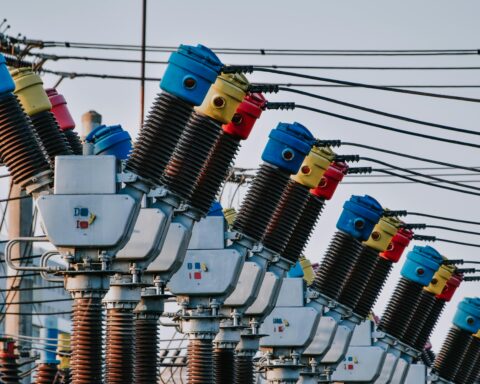As the U.S. Environmental Protection Agency looks to crack down on methane emissions, landfills are emerging as an underestimated source of climate pollution.
Methane is a potent greenhouse gas that traps about 80 times more heat in the earth’s atmosphere than carbon dioxide over a 20-year period. As the organic waste — mostly food waste — in landfills decomposes, it generates methane. A recent study in the journal Science suggests landfills are generating more methane than previously thought.
The study by the research group Carbon Mapper utilized airborne measurements to assess methane emissions from over 200 landfills across the United States. The study found that many landfills had “large methane ‘super-emitter’ plumes,” said Dan Cusworth, director of Science at Carbon Mapper and an author on the study. Following the study’s publication, the EPA initiated changes to methane reporting criteria that will take effect in 2025.
Landfills are the third-largest source of methane emissions overall, trailing the oil and gas industry and agriculture. However, landfills produce larger point-source emissions than any other industry, meaning an individual landfill will release far more methane than a single oil and gas well or animal feedlot. The Carbon Mapper study suggests landfill methane emissions may be higher and persist longer compared with previous estimates, highlighting the need for improved monitoring and mitigation strategies to address the problem effectively.
“There just haven’t really been many empirical measurements of landfill emissions across a large subset of landfills in the US or globally,” Cusworth said in an interview with Government Market News. The large methane plumes that Carbon Mapper found are at odds with the EPA estimates for landfill methane, leading Cusworth to conclude that “this is behavior that is not really well represented by the models.”
‘A lot of default assumptions’
Currently, landfills self-report their emissions through data to the EPA’s Greenhouse Gas Reporting Program. The data on landfill methane are approximations. One method is to estimate how much methane would be expected based on the amount of waste the landfill accepted that year.
Some landfills have gas collection systems in place to capture methane, and they use additional data on how efficient their system is and how much gas it collects. However, these models do not account for the possibility of system failures and the variability in how well gas-collection systems capture methane. Landfill operators also cover trash with a layer of soil that helps prevent methane from escaping, but the practice is not standardized. As a result, the reported emissions may not accurately reflect the true extent of the problem.
“There’s a lot of default assumptions,” Cusworth said. “Most landfills assume that they collect 75 percent of the gas.”
Katherine Blauvelt is the circular economy director at Industrious Labs, a group working to reduce emissions from industrial sectors of the economy. Blauvelt has worked extensively on solving the landfill methane problem and agrees that the Carbon Mapper study points to how the EPA reporting method is underestimating landfill methane emissions.
“The EPA has actually already acknowledged that the estimates that landfills report to them are flawed,” Blauvelt said in an interview with Government Market News. “They don’t account for the fact that gas collection systems can fail, they can fill with water, they can break,” she said, adding that “those basic conditions in a landfill actually do really impact how much methane is coming out of it.”
Gas collection systems are intended to stop methane from being released into the atmosphere. A network of pipes sucks the methane out of trash heaps. The gas can be burned to generate electricity. Some landfills connect to natural gas pipelines to send methane into the natural gas market, while others use it to fuel garbage collection trucks. The largest landfills in the U.S. are required to have gas collection systems in place.
While many landfills have gas collection systems, there has been evidence of large leaks, Blauvelt said.
“The EPA does not require landfills to monitor gas collection equipment for leaks, and problems,” Blauvelt said. “Obviously, if your pipes aren’t working to collect that gas, it’s game over.”
More needs to be done
The EPA’s Landfill Methane Outreach Program is a voluntary program that encourages landfill operators to capture and utilize landfill gas for energy production. Although this program has helped reduce methane emissions from landfills, the Carbon Mapper study suggests more needs to be done to address the issue comprehensively.
Following release of the study, the EPA initiated a rulemaking change to revise how methane emissions from landfills are reported. In a statement, an EPA spokesperson said the revised methodology for the Greenhouse Gas Reporting Program will include “updated factors” to “more accurately model landfill methane generation.”
The updated reporting method will include “expanding reporting requirements to account for potentially large emission events that are not currently well quantified,” an EPA spokesperson told Government Market News. The new rules will take effect in January 2025.
The EPA also responded directly to the Carbon Mapper study, with a spokesperson telling Government Market News, “The study’s results may indicate a need for multiple and prolonged measurements when comparing measurement data with annual inventory estimates to fully understand potential discrepancies in modeled emissions versus measured emissions.”
The EPA said “poor maintenance of cover materials, insufficient vacuum applied to wells, droughts creating cracks in the cover, and areas where wells are being drilled” could account for the high methane levels detected by the Carbon Mapper study.
At the end of 2023, the EPA released a ‘super emitter’ program for the oil and gas industry to monitor methane emissions. Both Blauvelt and Cusworth indicated landfills should have a similar program with enhanced direct measurement and monitoring of methane emissions using technologies such as aircraft, drones and satellites. These direct monitoring methods allow for targeted mitigation efforts.
Ultimately, experts agree diverting organic waste from landfills is the most effective solution to reducing landfill methane emissions. Reducing food waste through improved municipal composting would help lower methane emissions. In the meantime, climate policy advocates see a significant opportunity to reduce these emissions through improved landfill monitoring, leak detection and gas capture regulations.
“The EPA can take action today to prevent methane emissions that are everyday flowing unabated from landfills” Blauvelt said. “The single most effective solution out there to slow global warming is mitigating methane.”














